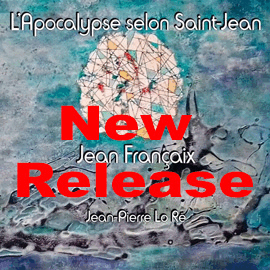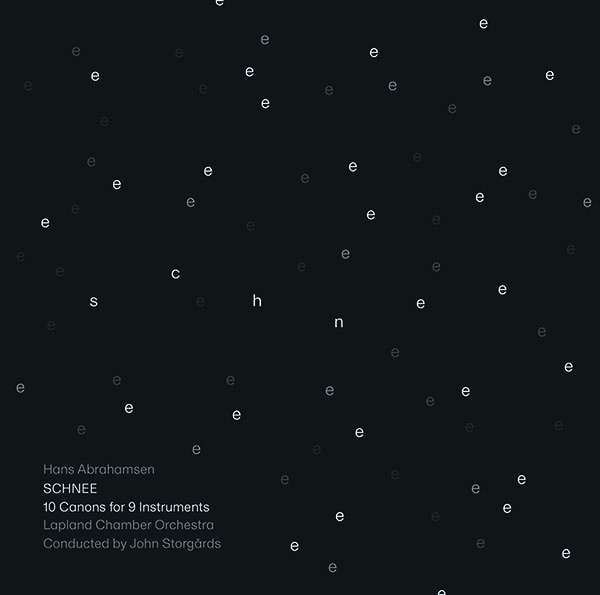Wohl rein zufällig wurde vor kurzem die Oper Die Schneekönigin, ebenfalls von Hans Abrahamsen, veröffentlicht (Rezension siehe unten). Das ist insofern eine passende Koinzidenz, als ‘Schnee’, das knapp einstündige Werk dieser Aufnahme, in vielfältiger Weise einen Bezug zur Oper hat und diese so nicht ohne das hier vorliegende Werk denkbar ist. So findet sich etwa das Schneemotiv in der Oper wie im ersten Kanon, die Szene der Oper, in der die Perfektion der Eiskristalle das Zentrum bildet, wurde im zweiten Kanon vorweggenommen.
Dieses Werk ‘Schnee’, das bei seiner Entstehung 2006-2008 das längste im Schaffen von Hans Abrahamsen war, gliedert sich in fünf doppelte Kanons und drei Intermezzi. Wobei die jeweils zwei zusammengehörenden Kanons miteinander verbunden sind, aber ebenso deutlich Unterschiede zeigen. Das fängt beim ersten an, in der ersten Version von den Streichern, in der zweiten Version von den Bläsern gespielt, wobei das nur ein äußerliches Beispiel ist. Dazu muss man wissen, dass die Instrumente in zwei Gruppen aufgeteilt sind, jeweils ein Klavier, links mit Streichern, rechts mit Bläsern. Als Drittes tritt das Schlagwerk hinzu. Die Kanons werden immer kürzer, von anfangs neun bis nachher nur noch einer Minute Dauer.
Dieses mit neun solistischen Musikern besetzte Werk zeigt eine weitgehend kristallin krispe Natur, die sich nur selten in eine dichtere Struktur verwirbelt, ohne deswegen undurchsichtig zu werden. Die Musiker des Kammerorchesters aus Lappland, vielleicht auch, weil sie solche Naturphänomene aus eigener Anschauung kennen, wissen diese verschiedenen Arten von Schnee mustergültig zu behandeln und die ebenso fragile wie scharfkantige Musik an das Ohr rieseln und stieben zu lassen, so dass sich als zusätzliche Imagination vor dem inneren Auge Bilder von Schneekristallen bilden können. Eine sehr kurzweilige Stunde fein ziselierter Töne, die ständig das Ohr reizen, aber nur selten ärgern, ist das Ergebnis dieser intensiven Verdeutlichung der Absichten des Komponisten.
Probably by pure coincidence, the opera « The Snow Queen », also by Hans Abrahamsen, was recently published (review underneath). This is a fitting coincidence in that Snow, the nearly hour-long work on this recording, relates to the opera in many ways, making it inconceivable without the work here. For example, the snow motif is found in the opera as well as in the first canon, ajm,nd the scene of the opera, in which the perfection of the ice crystals forms the center, was anticipated in the second canon.
This work, Snow, which was the longest in Hans Abrahamsen’s oeuvre when it was composed in 2006-2008, is divided into five double canons and three intermezzi. Each of the two related canons is connected to each other, but also clearly shows differences. This starts with the first, played in the first version by the strings, in the second version by the winds, although this is only an external example. For this, it is necessary to know that the instruments are divided into two groups, one piano on the left with strings, the other on the right with winds. The third is the percussion. The canons become shorter and shorter, from nine minutes at the beginning to only one minute later.
This work, with nine soloists, shows a largely crystalline crisp nature that only rarely swirls into a denser structure without becoming opaque because of it. The musicians of the chamber orchestra from Lapland, perhaps because they know such natural phenomena from their own experience, know how to treat these different types of snow in an exemplary manner and to let the music, which is as fragile as it is sharp-edged, trickle and tumble to the ear, so that images of snow crystals can form before the inner eye as an additional imagination. A very entertaining hour of finely chiseled tones, constantly teasing the ear but rarely annoying, is the result of this intense clarification of the composer’s intentions.




















